实验6:开源控制器实践——RYU
实验6:开源控制器实践——RYU
一、实验目的
能够独立部署RYU控制器;
能够理解RYU控制器实现软件定义的集线器原理;
能够理解RYU控制器实现软件定义的交换机原理。
二、实验环境
下载虚拟机软件Oracle VisualBox或VMware;
在虚拟机中安装Ubuntu 20.04 Desktop amd64,并完整安装Mininet;
三、实验要求
(一)基本要求
1.完成Ryu控制器的安装。

2.命令行运行
sudo mn --topo=single,3 --mac --controller=remote,ip=127.0.0.1,port=6633 --switch ovsk,protocols=OpenFlow10构建下图拓扑,协议使用Open Flow 1.0,并连接Ryu控制器
ryu-manager ryu/ryu/app/gui_topology/gui_topology.py --observe-links
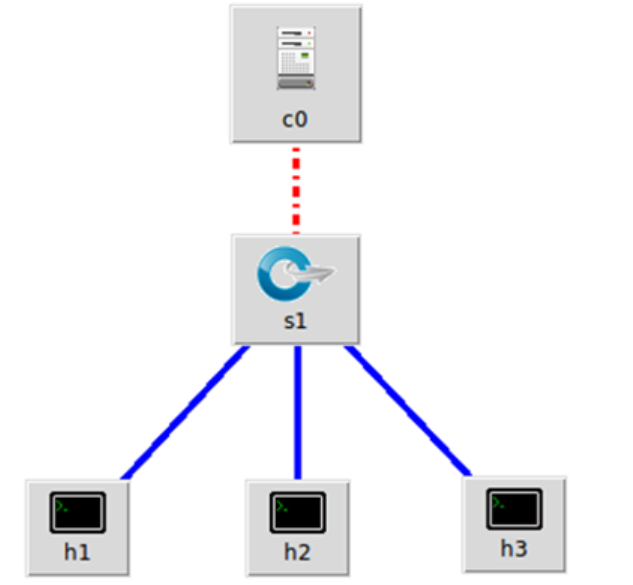
通过Ryu的图形界面查看网络拓扑。

阅读Ryu文档的The First Application一节,运行并使用 tcpdump 验证L2Switch,分析和POX的Hub模块有何不同。
L2Switch.py
from ryu.base import app_manager
from ryu.controller import ofp_event
from ryu.controller.handler import MAIN_DISPATCHER
from ryu.controller.handler import set_ev_cls
from ryu.ofproto import ofproto_v1_0
class L2Switch(app_manager.RyuApp):
OFP_VERSIONS = [ofproto_v1_0.OFP_VERSION]
def __init__(self, *args, **kwargs):
super(L2Switch, self).__init__(*args, **kwargs)
@set_ev_cls(ofp_event.EventOFPPacketIn, MAIN_DISPATCHER)
def packet_in_handler(self, ev):
msg = ev.msg
dp = msg.datapath
ofp = dp.ofproto
ofp_parser = dp.ofproto_parser
actions = [ofp_parser.OFPActionOutput(ofp.OFPP_FLOOD)]
data = None
if msg.buffer_id == ofp.OFP_NO_BUFFER:
data = msg.data
out = ofp_parser.OFPPacketOut(
datapath=dp, buffer_id=msg.buffer_id, in_port=msg.in_port,
actions=actions, data = data)
dp.send_msg(out)
h1 ping h2
h2,h3都收到数据包

h1 ping h3
h2,h3都收到数据包
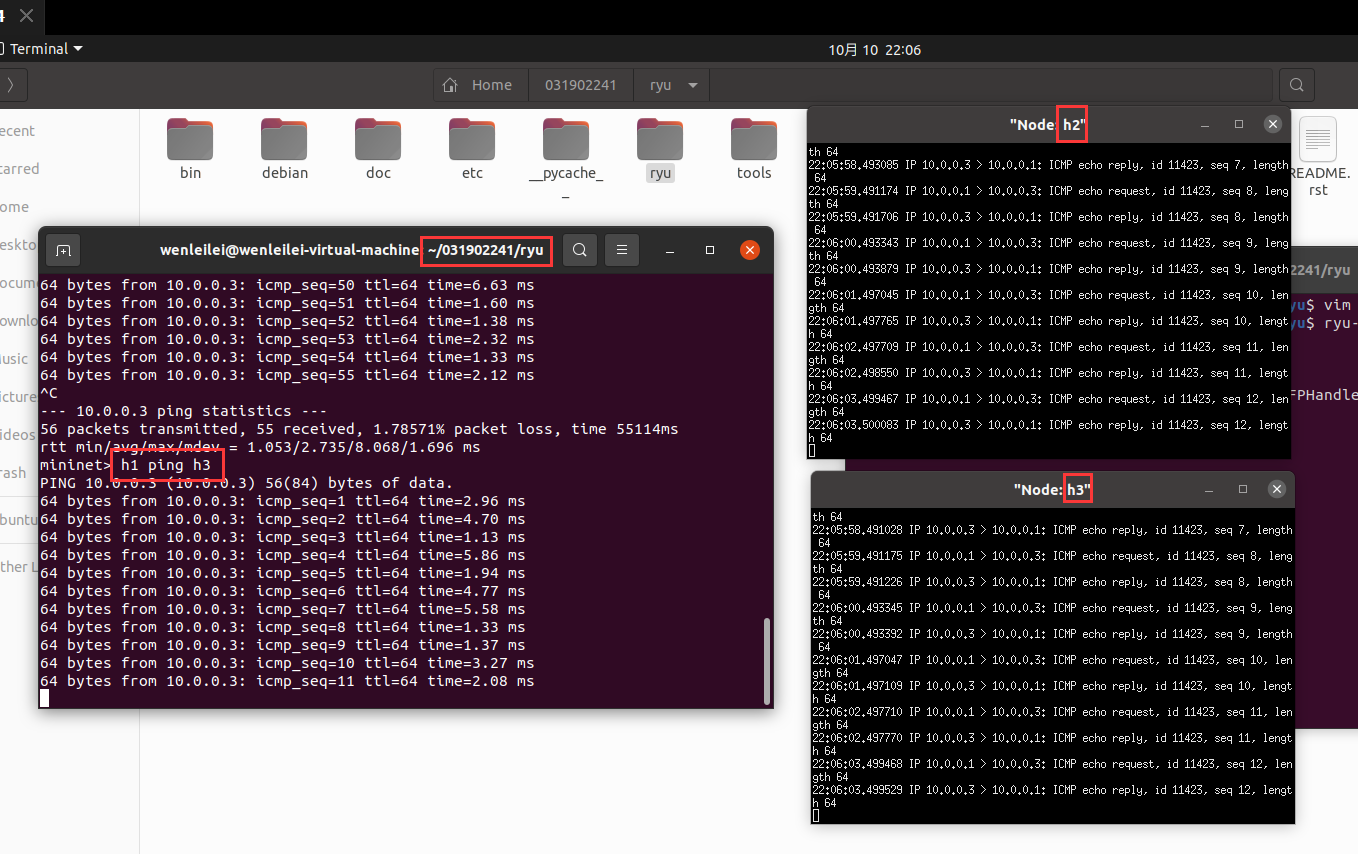
可以看到均为洪泛转发
查看控制器流表:
看到没有流表
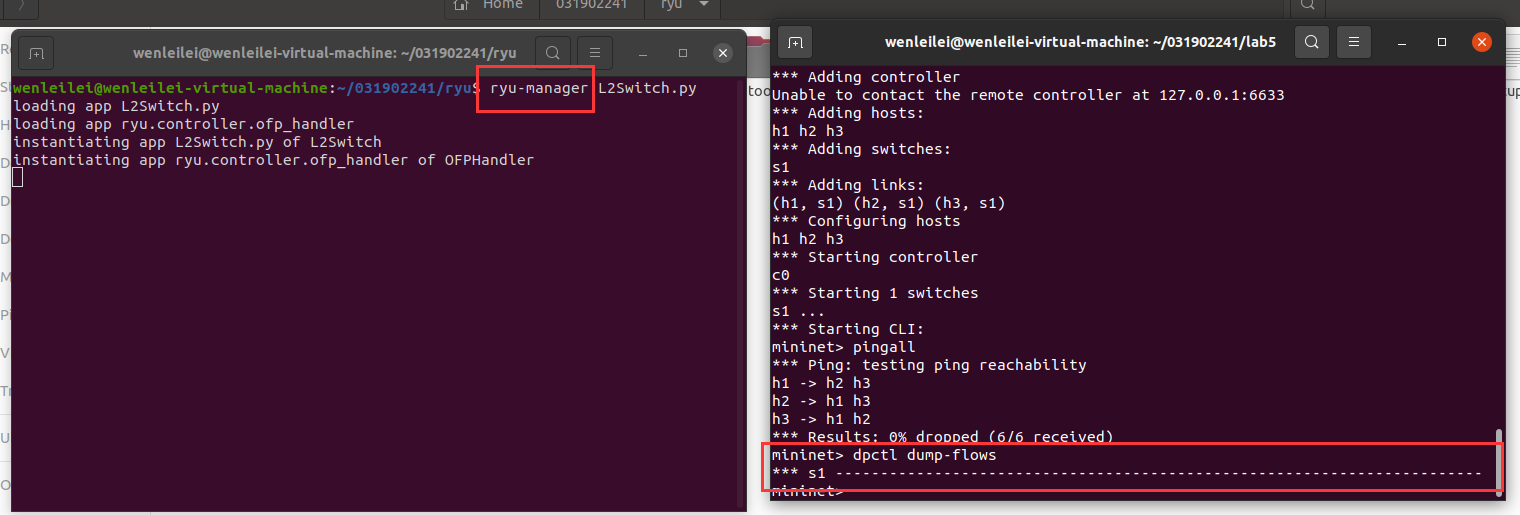
而使用pox的hub模块则会看到流表
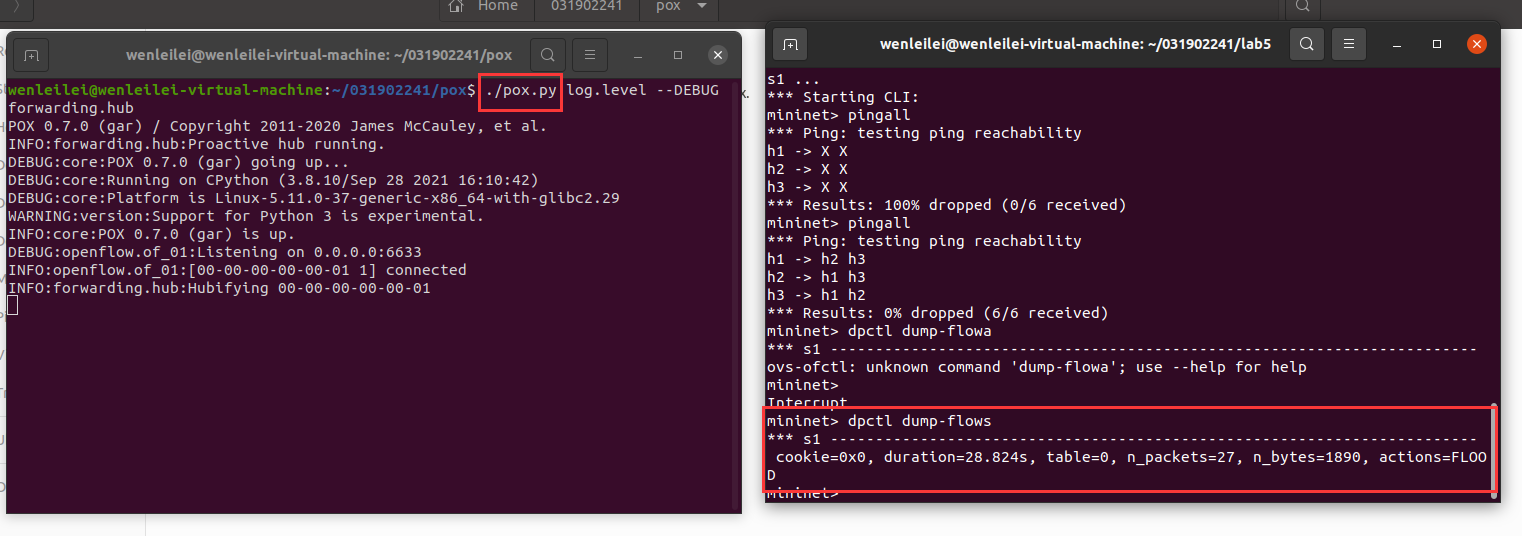
(二)进阶要求
1.阅读Ryu关于simple_switch.py和simple_switch_1x.py的实现,以simple_switch_13.py为例,完成其代码的注释工作:
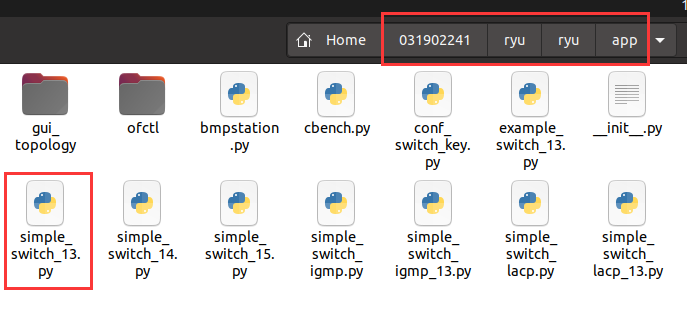
# Copyright (C) 2011 Nippon Telegraph and Telephone Corporation.
#
# Licensed under the Apache License, Version 2.0 (the "License");
# you may not use this file except in compliance with the License.
# You may obtain a copy of the License at
#
# http://www.apache.org/licenses/LICENSE-2.0
#
# Unless required by applicable law or agreed to in writing, software
# distributed under the License is distributed on an "AS IS" BASIS,
# WITHOUT WARRANTIES OR CONDITIONS OF ANY KIND, either express or
# implied.
# See the License for the specific language governing permissions and
# limitations under the License.
from ryu.base import app_manager
from ryu.controller import ofp_event
from ryu.controller.handler import CONFIG_DISPATCHER, MAIN_DISPATCHER
from ryu.controller.handler import set_ev_cls
from ryu.ofproto import ofproto_v1_3
from ryu.lib.packet import packet
from ryu.lib.packet import ethernet
from ryu.lib.packet import ether_types
# 引入包
class SimpleSwitch13(app_manager.RyuApp):
OFP_VERSIONS = [ofproto_v1_3.OFP_VERSION]
# 定义openflow版本
def __init__(self, *args, **kwargs):
super(SimpleSwitch13, self).__init__(*args, **kwargs)
# 定义保存mac地址到端口的一个映射
self.mac_to_port = {}
# 处理SwitchFeatures事件
@set_ev_cls(ofp_event.EventOFPSwitchFeatures, CONFIG_DISPATCHER)
def switch_features_handler(self, ev):
datapath = ev.msg.datapath
ofproto = datapath.ofproto
parser = datapath.ofproto_parser
# install table-miss flow entry
# We specify NO BUFFER to max_len of the output action due to
# OVS bug. At this moment, if we specify a lesser number, e.g.,
# 128, OVS will send Packet-In with invalid buffer_id and
# truncated packet data. In that case, we cannot output packets
# correctly. The bug has been fixed in OVS v2.1.0.
match = parser.OFPMatch()
actions = [parser.OFPActionOutput(ofproto.OFPP_CONTROLLER,ofproto.OFPCML_NO_BUFFER)]
self.add_flow(datapath, 0, match, actions)
# 添加流表的函数
def add_flow(self, datapath, priority, match, actions, buffer_id=None):
ofproto = datapath.ofproto
parser = datapath.ofproto_parser
# 获取交换机信息
inst = [parser.OFPInstructionActions(ofproto.OFPIT_APPLY_ACTIONS,actions)]
# 对action进行包装
# 判断是否有buffer_id,并生成mod对象
if buffer_id:
mod = parser.OFPFlowMod(datapath=datapath, buffer_id=buffer_id,
priority=priority, match=match,
instructions=inst)
else:
mod = parser.OFPFlowMod(datapath=datapath, priority=priority,
match=match, instructions=inst)
datapath.send_msg(mod)# 发送mod
# 处理PacketIn事件
@set_ev_cls(ofp_event.EventOFPPacketIn, MAIN_DISPATCHER)
def _packet_in_handler(self, ev):
# If you hit this you might want to increase
# the "miss_send_length" of your switch
if ev.msg.msg_len < ev.msg.total_len:
self.logger.debug("packet truncated: only %s of %s bytes",
ev.msg.msg_len, ev.msg.total_len)
msg = ev.msg
datapath = msg.datapath
ofproto = datapath.ofproto
parser = datapath.ofproto_parser
in_port = msg.match['in_port']
# 获取包信息,交换机信息,协议等等
pkt = packet.Packet(msg.data)
eth = pkt.get_protocols(ethernet.ethernet)[0]
if eth.ethertype == ether_types.ETH_TYPE_LLDP:
# ignore lldp packet# 忽略LLDP类型的数据包
return
# 获取源端口,目的端口
dst = eth.dst
src = eth.src
dpid = format(datapath.id, "d").zfill(16)
self.mac_to_port.setdefault(dpid, {})
self.logger.info("packet in %s %s %s %s", dpid, src, dst, in_port)
# 学习包的源地址,和交换机上的入端口绑定
# learn a mac address to avoid FLOOD next time.
self.mac_to_port[dpid][src] = in_port
# 查看是否已经学习过该目的mac地址
if dst in self.mac_to_port[dpid]:
out_port = self.mac_to_port[dpid][dst]
# 如果没有则进行洪泛
else:
out_port = ofproto.OFPP_FLOOD
actions = [parser.OFPActionOutput(out_port)]
# 下发流表处理后续包,不再触发PACKETIN事件
# install a flow to avoid packet_in next time
if out_port != ofproto.OFPP_FLOOD:
match = parser.OFPMatch(in_port=in_port, eth_dst=dst, eth_src=src)
# verify if we have a valid buffer_id, if yes avoid to send both
# flow_mod & packet_out
if msg.buffer_id != ofproto.OFP_NO_BUFFER:
self.add_flow(datapath, 1, match, actions, msg.buffer_id)
return
else:
self.add_flow(datapath, 1, match, actions)
data = None
if msg.buffer_id == ofproto.OFP_NO_BUFFER:
data = msg.data
out = parser.OFPPacketOut(datapath=datapath, buffer_id=msg.buffer_id,
in_port=in_port, actions=actions, data=data)
# 发送流表
datapath.send_msg(out)
2.并回答下列问题:
a) 代码当中的mac_to_port的作用是什么?
答:mac_to_port保存mac地址到交换机端口的映射。
b) simple_switch和simple_switch_13在dpid的输出上有何不同?
答:差别如下:
#simple_switch.py
dpid = datapath.id
...
#simple_switch_13.py
dpid = format(datapath.id, "d").zfill(16)
...
simple_switch直接输出dpid,simple_switch_13会在dpid前端加上0将其填充至16位。
c) 相比simple_switch,simple_switch_13增加的switch_feature_handler实现了什么功能?
答:实现交换机以特性应答消息响应特性请求
d) simple_switch_13是如何实现流规则下发的?
答:在接收到packetin事件后,首先获取包学习,交换机信息,以太网信息,协议信息等。如果以太网类型是LLDP类型,则不予处理。如果不是,则获取源端口目的端口,以及交换机id,先学习源地址对应的交换机的入端口,再查看是否已经学习目的mac地址,如果没有则进行洪泛转发。如果学习过该mac地址,则查看是否有buffer_id,如果有的话,则在添加流动作时加上buffer_id,向交换机发送流表。
e) switch_features_handler和_packet_in_handler两个事件在发送流规则的优先级上有何不同?
回答:switch_features_handler下发流表的优先级比_packet_in_handler高。
(三)个人总结
- 实验难度:本次实验基础部分难度较低,进阶部分难度较高。ryu的安装较为简单,只需要在命令行运行相关命令即可,而基础部分的实验操作和实验五差不多,因此感觉难度较低。进阶部分由需要阅读源码,并且需要对openflow协议有一定的程度的理解,难度较高,也花费了我较多的时间。
- 实验中遇到的困难及解决办法
创建的L2Switch.py文件要放在正确的路径下,并在该文件目录下运行相关命令

- 个人感想
本次实验学习并实践了ryu控制器,并进一步巩固与强化了openflow协议的相关知识,这几次的实验都涉及到源代码,可能因为源码本身阅读起来难度就比较大,所以一看到源代码我就觉得头大,但是花费时间好好学习下来还是会觉得收获颇丰。




